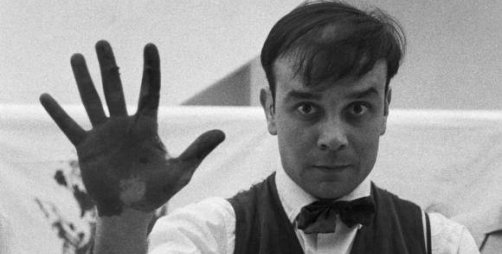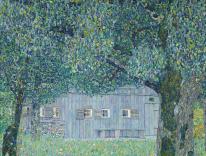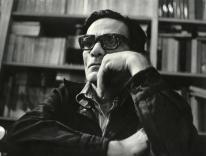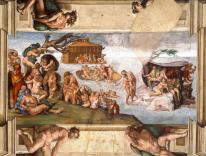
At the age of nineteen, the mid-twentieth-century French artist Yves Klein signed the sky above Nice as his first artwork. The same year he began to compose a symphony that consisted of a single note for twenty minutes, followed by twenty minutes of absolute silence. Later, having renounced paintbrushes as “too excessively psychological,” Klein employed nude, paint-smeared female models as “living brushes.” And once, after emptying the Galerie Iris Clert in Paris of everything in it, he dubbed his exhibition “The Void.” These gestural flights, with which he rivaled Marcel Duchamp as an impresario of the improbable, once led Paris Match to call Klein “the greatest painter in the world.”
Born in Nice in 1928 to the figurative painter Fred Klein and Marie Raymond, an abstractionist, young Yves was an indifferent student whose first passion was judo. After spending a year in Japan (1952–53), where he earned a black belt, he was refused recognition by the French Judo Association and turned to art. His first exhibition, in 1955, was monochrome paintings of various sizes in vivid colors. This summer a selection of these early monochromes kicked off “Yves Klein: With the Void, Full Powers” at the Hirshhorn Museum in Washington, D.C. (The title comes from Albert Camus’s comment in the guest book for “The Void.”) The exhibit moves to the Walker Art Center in Minneapolis on October 23 (through February 13, 2011). It is Klein’s first major retrospective in the United States since 1982.
The show documents how Klein’s remarkably fertile (and assertive) imagination anticipated minimalism, conceptualism, and later, even performance and installation art. When his critic and friend Pierre Restany associated Klein with the Russian suprematist Kasimir Malevich, Klein protested. “I am not an abstract painter but, on the contrary, a figurative artist, and a realist.” Elsewhere he wrote, “My monochrome propositions are landscapes of freedom.” (When, some years later, he prophesied an age of “impersonal ontology,” the apparent contradiction was welcome. An artist, he thought, must contradict himself.)
Debonair and articulate, with an air both angelic and arrogant, Klein was a marketing genius. In 1956 he decided to paint only in blue—and patented his International Klein Blue (IKB), an ordinary ultramarine with a polymer binder to preserve its intensity. His presentation of eleven identical blue monochromes at the Galleria Apollinaire in Milan drew wide attention, and the examples from this “Blue Epoch” in the present show are a marvel, almost justifying the religiously transcendent language with which Klein spoke of the color. The largest piece, California, from 1961, reflects a trip he took to Los Angeles—and Disneyland—with his studio assistant, the beautiful young German Rotraut Uecker, whom he married the following year.
Noticing how the sponges he used to apply the IKB absorbed the pigment, in the late 1950s Klein began to attach them to panels as “sponge reliefs.” Employing metal stems on stone or wood, they also became freestanding sculptures. Klein’s commission for the Gelsenkirchen Opera House in Germany featured both canvases and sponge reliefs. In the exhibition there is a show-stopping gallery with a single large sponge relief surrounded by a “forest” of eighteen sponge sculptures, all in radiant IKB.
Apart from Klein Blue, the artist is perhaps best known for his series of “Anthropometries,” beginning in 1958, in which models covered with IKB worked images of themselves onto paper later mounted on canvas. (Sometimes the artist would simultaneously conduct his Monotone-Silence Symphony in white tie and tails.) The canvases evoke radioactive images (Hiroshima, c. 1961), a tumble of levitating human figures (People Begin to Fly, 1961), or a complex splash of blue on beige, much like a typical abstract expressionist work (Jonathan Swift, c. 1960).
For a brief but productive period in 1961, Klein also experimented with Fire Paintings, using a blowtorch to sear painted or even bare canvases (and sometimes the outlines of nude models “painting” a canvas). Derived from his belief in fire as “the universal principle of expression,” the results yielded a new palette of deep red-browns, fiery oranges, and yellows roiling like thin mists across the picture surface. A similar spatial sense can be found in his Cosmogonies and Planetary Reliefs from the same period. They evoke not only fiery origins but also immense interstellar space.
Klein’s meteoric career was cut short by a fatal heart attack in 1962. Throughout his professional life, the intensity of his inventions was accompanied by a utopian vision particularly evident in his “architecture of air” projects (he imagined future cities as new Edens built with fire, water, and air). The curators of the exhibition go a bit gaga over Klein’s “revolutionary importance.” Kerry Brougher writes in the catalogue that, “like some strange object,” Klein came for only a short time “from the heavens to open our eyes and minds.” Philippe Vergne is even more rhapsodic: “Barely older than Jesus when he died, Klein’s imprint on the creative landscape of the second half of the last century is as deep as that of a stigmata.” Still, the exhibition does reveal how Klein, besides producing some enduringly compelling work of his own, had a catalytic effect on the art of his time.
Some have traced Klein’s inspiration to his Catholic faith. (Once, on a visit to the shrine of St. Rita of Cascia in Italy, he prayed “in the name of the Father, and in the name of the Son, and in the name of the Holy Spirit, and in the name of the Holy Virgin: May all that emerges from me be beautiful.”) But there is little evidence in the show of a sacramental imagination, which would scarcely suit the artist’s dream of an “immaterial sensibility.” Existentialism seems not to have interested him either, and the Algerian War, which coincided exactly with his career, goes without notice. Eastern philosophy and especially Rosicrucianism, which Klein read almost obsessively, seem to have been the dominant influences on an artist who longed to make something entirely new—and succeeded perhaps most of all in creating himself.
Please email comments to [email protected] and join the conversation on our Facebook page.
Share
Previous Story
Undimmed
Next Story
‘Credo in Newmanum’


